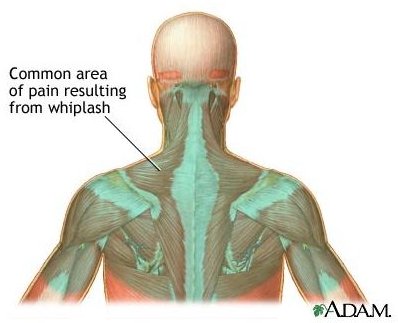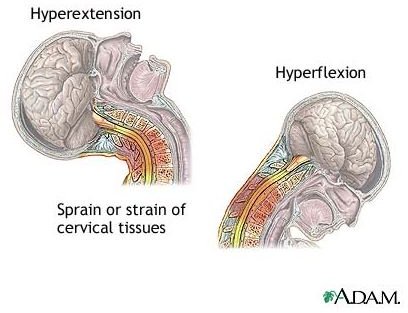What is Whiplash? Find Information about Whiplash
What is Whiplash?
Whiplash is a neck injury (also known as neck strain or neck sprain) that occurs when the head has an abrupt jerking motion, usually similar to a whip cracking (thrown backward then forward). The extreme motions cause the neck muscles and ligaments to be pushed beyond their normal limit. Damage can involve muscles, ligaments, intervertebral joints, discs, and/or nerve roots. Women are more likely to get whiplash than men (probably because most women do not have necks as strong as men).
Causes
Common causes of whiplash include :
- car accidents, particularly rear-end collisions
- physical abuse, including shaken baby syndrome
- trauma, like being punched in the face
- contact sports, like football.

Symptoms
Whiplash symptoms may be delayed for 24 hours or longer after the incident; however, most develop within 24 hours. Symptoms may include one or more of the following:
- neck pain and stiffness
- headaches (normally at the base of the skull)
- dizziness
- ringing in the ears
- blurred vision
- fatigue
- irritability
- sleep disturbances
- difficulty concentrating
- difficulty remembering
- pain in the shoulders
- pain between the shoulder blades
- weakness, tingling, or numbness in the arms.
Diagnosis
Injuries involving soft tissues, such as muscles and ligaments, can not be detected using standard x-rays. More sophisticated imaging tests, such as a MRI (magnetic resonance imaging) or a CT (computerized tomography) scan, are normally needed to diagnose whiplash.
Treatment
Now that you know “what is whiplash”, let us learn what the treatment for whiplash is.
Collars
In the past, a soft foam cervical collar was used to keep the neck immobilized. However, it was discovered that wearing the collar for long periods of time actually impaired recovery time by decreasing muscle bulk and strength. The collar is still used today but only for the first few days and only for a few hours at a time (usually no more than 3 hours).
Ice/Steroids
The application of ice is important in the early part of recovery (especially the first 24 hours). This will help reduce inflammation. A corticosteroid injection may be given which will also help decrease inflammation.
Pain Medications/Muscle Relaxants
Pain medications are given to help control pain. Over-the-counter medications (such as tylenol or ibuprofen) are usually suffice for mild to moderate pain. For severe pain, prescription painkillers are often given but this should only be for a short period of time. Muscle relaxants may also be given to help ease muscle spasms (these are normally taken at night because they can cause drowsiness).
Exercise/Heat
When the pain is under control, gentle stretching exercises (as instructed by a doctor or physical therapist) should be performed to help restore the neck’s strength and range of motion. The application of heat to the neck can be helpful in relaxing muscles before performing exercises.
Alternative Treatments
Alternative treatments that may help relieve pain and cure whiplash include:
- acupuncture
- massage
- transcutaneous electrical nerve stimulation (TENS).
The recovery time for whiplash can be a few weeks or a few months. Some people may develop chronic problems that can be disabling.
Sources Used
https://www.webmd.com/pain-management/guide/pain-management-whiplash
https://www.mayoclinic.com/health/whiplash/DS01037
Photo Credit
Images courtesy of the National Library of Medicine (NLM).
